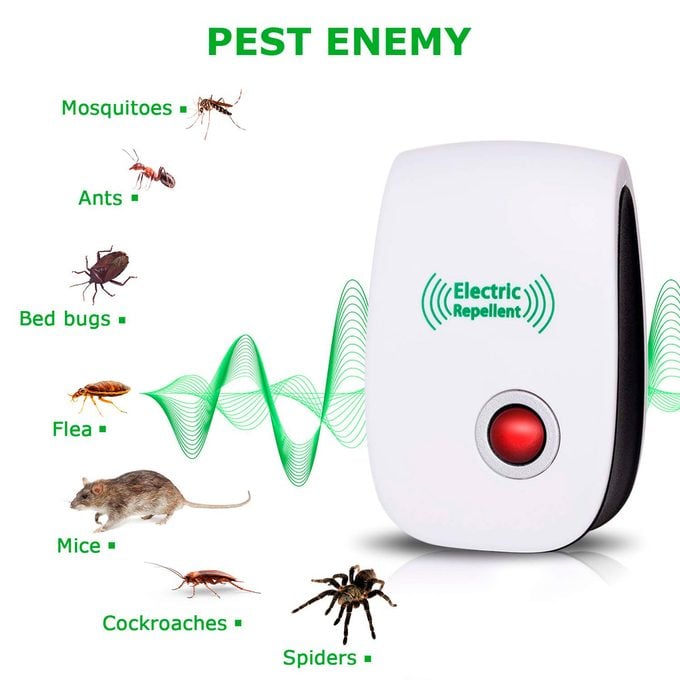Ultrasonic pest control devices repel rodents, insects and wild game. They're also safe for use around pets and small children.
Our editors and experts handpick every product we feature. We may earn a commission from your purchases.Learn more.
Ultrasonic pest control devices repel rodents, insects and wild game. They're also safe for use around pets and small children.
Our editors and experts handpick every product we feature. We may earn a commission from your purchases.Learn more.

If you have pets or small children or are concerned about your chemical exposure, you may be interested in purchasing an ultrasonic pest control device. Whether you want to repel rodents, insects or wild game, a device exists. Let’s see how they operate and if they accomplish their intended purpose.
On This Page
Ultrasonic pest repellers, once plugged into an electrical outlet, operate by emitting short-wavelength, high-frequency sound waves that are too high for humans to hear. The average young person hears sounds ranging from 20 to 20,000 Hz, whereas a middle-aged person only hears up to 12-14,000 Hz. Animals and insects hear sounds in a much higher range. On average, ultrasonic devices emit a sound at about 65,000 Hz, which, according to ultrasonic pest control device manufacturers, chases the pests away.
Remember that if you did a few things around the home to deter pests, you might not need to resort to other methods. This includes sealing gaps, repairing screens and moving your firewood pile. There are also DIY pest control methods.

Using the latest and greatest ultrasonic chip, these easy-to-use devices repel mice, rats, spiders, fleas, cockroaches, ants, flies and mosquitoes, driving them from your home and property.
To get these to work, you just have to plug them into an outlet in your home. However, for the best results, you’ll want to use outlets 10-30 inches off the floor. Furthermore, you should space them out around your house (as opposed to bunching them together in a single area) to cover the most ground. Once they’re plugged in, your job is done. Within the first few days, you may see increased pest activity as they react to the ultrasonic devices, but they should clear out within a couple of weeks and by week three or four, your home should be pest-free.
Verified Amazon buyer L. Colburn gave these pest repellers a five-star review, stating, “I have noticed a very definite reduction in insects in our house. Living in the country, it is a common problem. These are a very good product.”
“Works very well on my farmstead, with it being an older home there are always bugs in the books and crannys and cracks but with the peat repellent plug in I have noticed that the bugs have begun to disappear!” says Chelsea, another Amazon Verified customer who also gave these a five-star review.

Covering up to 1200 square meters, each of these pest-repelling electric devices is human- and pet-friendly, creating no noises, smells, radiation, or otherwise.
On average, an ultrasonic pest repeller lasts three to five years. You know it’s working if the LED light on the device is lit. You can buy a six-pack of these devices on Amazon for $20. The ultrasonic device is cost-effective because sprays must be reapplied, and traps must be replaced frequently.
Because the EPA doesn’t regulate these devices, some folks are skeptical of their claims. According to an article by the BBC, entomologist Bart Knols asserts there is “no scientific evidence whatsoever” that ultrasound repels mosquitoes. The results of scientific studies for such products are all over the map, showing some pests respond while others don’t. However, many of these types of products on sites for online retailers have plenty of five-star reviews.
Although the use of electronic sound to control pests gained momentum in the 1950s and ’60s, experimentation with this technology started as early as 1948. The first patent for an ultrasonic pest device was issued in the 1960s. Many more patents have been issued since.
While the National Institutes of Health suggests that people who are exposed to ultrasonic noise over time can suffer from nausea, headaches and migraines, ringing in the ears (tinnitus), and fatigue, the NIH has also conducted extensive research, discovering that “ultrasonic noise has little effect on general health unless there is direct body contact with a radiating ultrasonic source.” In short, ultrasonic pest repellers shouldn’t affect humans much. However, pets can hear a wider range of sounds, and these kinds of devices may affect them negatively (if a mouse can hear it, a cat or dog may be able to, as well, and it will be as unpleasant to them as it is to mice).
As long as the device is powered, it should be as effective as it was brand-new. However, you may need to replace it every three to five years, at which point it will have reached its effective life. Those whose batteries can be replaced may last longer, however.
Probably not. Think of an ultrasonic pest repeller as a light source that won’t effectively penetrate solid surfaces like walls, floors and ceilings. The sound that does penetrate these surfaces will be muffled and ineffective.
No, these ultrasonic sounds should not be audible to the human ears. Lower-quality and/or broken devices may emit audible frequencies, but that’s not good, and they should be replaced ASAP.